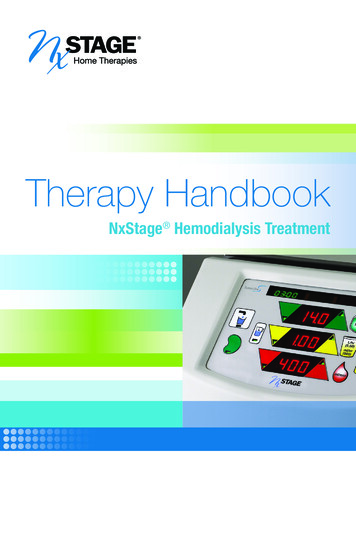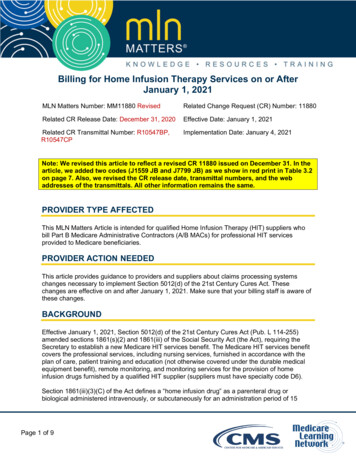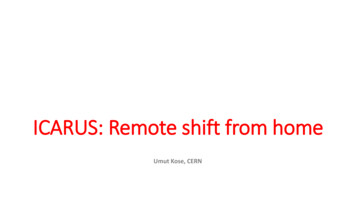
Transcription
Therapy HandbookNxStage Hemodialysis Treatment
2
Table of ContentsSection One:ADEQUACY AND DOSING . . . . . . . . . . . . . . . . . . 7Section Two:THE DIALYSATE . . . . . . . . . . . . . . . . . . . . . . . . . . 13Section Three:GETTING STARTED . . . . . . . . . . . . . . . . . . . . . . . 16Section Four:THE PUREFLOWTM SL SYSTEM . . . . . . . . . . . . . . 19Section Five:TRAINING AND LOGISTICS . . . . . . . . . . . . . . . . . 36Appendix A:DIALYSATE CATALOG . . . . . . . . . . . . . . . . . . . . . . 39Appendix B:WATER PURIFICATION WITHTHE PUREFLOWTM SL SYSTEM . . . . . . . . . . . . . . 40Appendix C:SUMMARY OF DRINKING WATERSTANDARDS AND SPECIFICATIONS . . . . . . . . . . 42Appendix D:GUIDANCE FOR EVALUATING THEDIALYSATE CULTURE TEST RESULTS . . . . . . . . . 44Appendix E:GUIDANCE FOR EVALUATING THEDIALYSATE ENDOTOXIN TEST RESULTS . . . . . . 453
IntroductionThe simplicity and portability of the NxStage System One has ignited a newwave of home hemodialysis (HHD) and flexible in-center therapy adoption.The system has been used to perform millions of treatments, on thousandsof patients, revolutionizing the way patients and providers think abouthemodialysis therapy.1NxStage’s innovative system design is:Simple to learn and operateAllows therapy choice Drop-in cartridge Treatment schedule and location Simple interface No significant home modificationsPays attention to safetyPortable and flexible Comprehensive self-testsautomatically performedbefore each treatment Compact No unique electrical requirementsThis document outlines some key concepts of hemodialysis therapy with theNxStage System One. It incorporates the perspectives of some of the clinicalinvestigators and advisors to NxStage, and assumes knowledge of the system’scomponents. For additional details on the system components, see The NxStageSystem One product brochure, APM494 or outside of the US: APM964. NxStagehas prepared this document as an introduction; it does not address all topicscritical for managing a patient on the NxStage System One therapy. It is alwaysthe physician’s responsibility to ensure the appropriate prescription, therapy, andcare plan for an individual patient.Personal and Partner Responsibility in the HomeHome hemodialysis with NxStage requires a patient and partner who arecommitted to being trained on and following the guidelines for proper systemoperation. If a patient chooses home hemodialysis, he or she will be responsiblefor complying with the dialysis prescription, which may require treatments upto six days per week. Each treatment can take about 2½ to 3 hours or moreincluding set-up and tear-down.If the patient chooses to do home hemodialysis, the patient and his/her partnerwill need to take on the responsibility for tasks that would normally be takencare of by center staff when receiving treatment in-center. They will need toperform all aspects of the dialysis treatment from start to finish, including setting4
up the dialysis equipment, needle insertion, responding to and resolving allsystem alarms, and system tear-down at the end of treatment.In addition, patients must monitor their blood pressure, ensure that properaseptic technique is followed, and follow all of the training material andinstructions given by the training nurses. Patients and their partners will alsobe trained on and need to know how to respond to any health emergenciesthat might happen during treatment at home, including dizziness, nausea,hypotension, and fluid or blood leaks.Home Treatment EnvironmentTo do home hemodialysis successfully, patients must take care to ensure thatthey have a clean and safe environment for their treatments. They will also needto set aside space in the home for the needed supplies.Risks Associated with All Forms of HemodialysisAll forms of hemodialysis, including treatments performed in-center and at home,involve some risks. These may include high blood pressure, fluid overload, lowblood pressure, heart-related issues, vascular access complications, cramps,backache, headache, dizziness, nausea, an “off” taste in the mouth, fatigue,fever, chills, joint pain, itching, seizures or sinusitis.All hemodialysis therapies also involve the use of medical devices that introducethe potential for additional risks including air entering the bloodstream, damageof red blood cells, inflammatory reactions, blood chemistry imbalances, bloodloss due to clotting of the blood tubing set or accidental blood line disconnectionor other leak, allergic reactions, and excess warming or cooling of the dialysate.In addition, dialysis patients may have other underlying diseases that may, in somecases, make it more difficult for them to manage their hemodialysis treatments.5
Home Nocturnal HemodialysisThe NxStage System One may be used at night while the patient and carepartner are sleeping. Treatment with nocturnal therapy may require adjustmentsto medications, including but not limited to iron, Erythropoiesis-StimulatingAgents (ESA), insulin/oral hypoglycemics, anticoagulants, and phosphatebinders.Product Disclaimer: Not all products are cleared or available for sale in all countries.6
SECTION ONE:ADEQUACY AND DOSINGDetermining Treatment OptionsNxStage System One is designed around the intersection of portability andflexibility, empowering patients to fit dialysis into their unique lifestyle. SystemOne patients can choose from an array of possible therapy options such asconventional thrice weekly to more frequent dialysis, all while having the optionto travel with their cycler.The NxStage Dosing Calculator allows you and your patients to work together tosee what fits into their schedule while meeting clinical needs. Designed and builtfrom scientific formulas and peer-reviewed journals, the calculator quickly andeasily provides patient-specific therapy treatment schedules including frequency,treatment duration and volume, dialysate and blood flow rates. Compatible withdesktop and mobile devices, the calculator is available when and wherever youneed it.Visit https://dosingcalculator.nxstage.com to try the dosing calculator today.It is essential to remember these methods only provide starting estimates whichwill need to be adjusted based on actual patient experience. A physician mustultimately decide, prescribe, and adjust the appropriate fluid volume for a patient.7
Time Efficiency (Conventional) vs Water Efficiency (NxStage);High Dialysate SaturationIn conventional hemodialysis, the objective is to deliver as much therapy (andclearance) as possible, in a set amount of time (3-4 hours, 3 times weekly). Asshown in Figure 1, this is accomplished by running dialysate flow rates over500 mL/min. At these high flow rates, clearance rate per unit of dialysate islower and the spent dialysate is less saturated. A good analogy for this isfound in peritoneal dialysis (PD), where less saturated dialysate means thereis a low ratio of solute concentrations in dialysate and plasma [D/P ratio]. As aresult, conventional in-center dialysis requires large volumes of water to achievetargeted clearance through on-line dialysate production systems.Figure 1*Generating large volumes of high quality fluid may be challenging, especially inthe home setting. In the home or flexible in-center setting, a therapy should beefficient in its use of fluid, and dialysate should be used to its fullest potential.When the therapy can be scheduled with greater flexibility, time efficiency is nolonger a primary driver.As depicted in Figure 1, NxStage therapy achieves high fluid efficiency byoptimizing the effective dwell time of the dialysate in the dialyzer itself. This occurswhen blood flow rate is high relative to the dialysate flow rate. Dialysate saturationexceeds 90% when blood flow rate is approximately 3 times dialysate flow rate.2Figure 1 References:Daugirdas et al, Solute-solver: a web-based tool for modeling urea kinetics for a broad range ofhemodialysis schedules in multiple patients. Am J Kid Dis. 2009;54(5):798-809Gotch et al, Effective diffusion volume flow rates (Qe) for urea, creatinine, and inorganic phosphorus(Qeu, Qecr, QeiP) during hemodialysis. Sem Dial. 2003;16(6):474-476* Assumes patient total body water of 42 Liters.8
spKt/V vs eKt/V vs stdKt/VKt/V, or clearance normalized to patient total body water, is the commonly usedstandard by which therapy dose is measured and compared. However, there aremultiple variants of Kt/V: spKt/V (single pool): The most common “per-treatment” dose, measuredin hemodialysis using pre-Blood Urea Nitrogen (BUN) and post-BUN levelsand a conversion formula (as described in K-DOQI). spKt/V does notincorporate posttreatment rebound, and may lead to incorrect conclusionswhen comparing treatments of different durations and/or frequencies. eKt/V (equilibrated): Also a “per-treatment” dose. Generally accepted tobe a more meaningful measure of actual dose delivery in a given dialysissession, as it incorporates postdialysis rebound. Rebound becomes moresignificant when clearance rates are high and/or treatment times are short.eKt/V is difficult to measure directly in routine clinical practice. Because it’sdifficult to measure eKt/V directly, several formulas (“rate equations”) havebeen established to translate spKt/V to eKt/V. Daugirdas-Schneidtz, HEMO,Tatersall, Leypoldt, etc. The Daugirdas equation3 is widely used toestimate actual rebound across a range of therapy rates and durations.However, as with spKt/V, eKt/V may lead to incorrect conclusions whencomparing treatments at different frequencies. stdKt/V (standardized): A “weekly” dose, originally proposed by Gotch4,hasbecome widely accepted. This measure was developed to allow comparisonof therapies of different durations and schedules (as referenced above,neither spKt/V or eKt/V can be simply added together for comparison).Therapy regimens are considered to deliver equivalent doses if theaverage pretreatment BUN concentrations are equal. This model takesinto consideration the kinetics advantages of more frequent and/or longertherapies. stdKt/V is not directly measured, but can be calculated usingspKt/V, treatment time, and frequency. K-DOQI Guidelines5 recommend anspKt/V which translates into a minimum stdKt/V of 2.0.The NxStage Dosing calculator allows users to set a target weekly stdKt/V.This value sets the stdKt/V that will be provided by all choices in the Optionstable. URR (urea reduction ratio): The ratio of post and pretreatment BUN levels.It is an integral component of the spKt/V calculation. However, it does notcapture the impact of net fluid removal, or the duration of therapy. As such,K-DOQI discourages the sole use of URR.9
Several sample therapy schedules, delivering the same stdKt/V, are depicted below:*Figure 2*ScheduleRegimen ARegimen BRegimen CRegimen D3x4 Hours3.5x4 Hours3.5x8 Hours6x2 HoursstdKt/V2.0(calculated weekly .41(what is measured)(what can be calculated)stdKt/Vb‡2.4(calculated weekly hat is measured)(what can be calculated)Higher clearances can be achieved. For example, a stdKt/V of 4.0 could beachieved by the following regimens:Figure 3*ScheduleRegimen ARegimen B4x8 Hours5x2 HoursstdKt/V4.0(calculated weekly dose)spKt/Va2.361.95eKt/Vb*2.001.47(what is measured)(what can be calculated)References:Daugirdas et al, Solute-solver: a web-based tool for modeling urea kinetics for a broad range ofhemodialysis schedules in multiple patients. Am J Kid Dis 2009; 54(5): 798-809Gotch et al, Effective diffusion volume flow rates (Qe) for urea, creatinine, and inorganic phosphorus(Qeu, Qecr, QeiP) during hemodialysis. Sem Dial 2003; 16(6): 474-476* Assumes patient total body water of 42 Liters.† ‡aDaugirdas JT. Second generation logarithmic estimates of single-pool variable volume Kt/V:an analysis of error. J Am Soc Nephrol 1993;4:1205-1213.bLeypoldt et al, Predicting treatment dose for novel therapies using urea standard Kt/V.Semin Dial 2004; 17(2):142-145.10
Choosing a Target per Treatment spKt/VA weekly stdKt/V target dose can be translated into a per-treatment spKt/V forany given treatment regimen (frequency and duration). The spKt/V is importantbecause it can be routinely measured with pretreatment and posttreatmentblood samples to monitor therapy delivery.Approximate per session Kt/V (spKt/V) to achieve equivalent urea clearances(weekly standardized Kt/V (stdKt/V) 2.0)2.02.4spKt/V per reatments per weekWhile many different treatment schedules are utilized, NxStage therapy has oftenbeen administered 5x or 6x weekly for 2.5-3 hours per treatment. In this schedule, aspKt/V of 0.42-0.51 for 6 days per week, and 0.54-0.68 for 5 days per week, delivera weekly stdKt/V of approximately 2.0 and 2.4, respectively, which meets or exceedsthe K-DOQI minimum threshold of 2.0. It is important to remember that no consensuson the ideal dose exists, so prescriptions must be tailored to individual patient needsbased on physician judgment.Effluent (“Drain”) Volume Divided by Body Water Approximates spKt/VFormulae aside, Kt/V is intended to convey a relatively simple concept – volumecleared divided (“normalized”) by total volume. Total volume is approximatedby a patient’s total body water (determined by an appropriate anthropometricformula or otherwise). Also, when the dialysate is highly saturated (fluid efficiency),effluent volume approximates total volume cleared.For NxStage therapy delivered more frequently, Kt/V can be very roughlyapproximated by dividing total effluent (dialysate plus net ultrafiltration) byestimated total body water. So, to deliver a spKt/V of 0.5 to a patient with 40 Lof t
the home setting . In the home or flexible in-center setting, a therapy should be efficient in its use of fluid, and dialysate should be used to its fullest potential . When the therapy can be scheduled with greater flexibility, time efficiency is no longer a primary driver . As depicted in Figure 1, NxStage therapy achieves high fluid efficiency by











